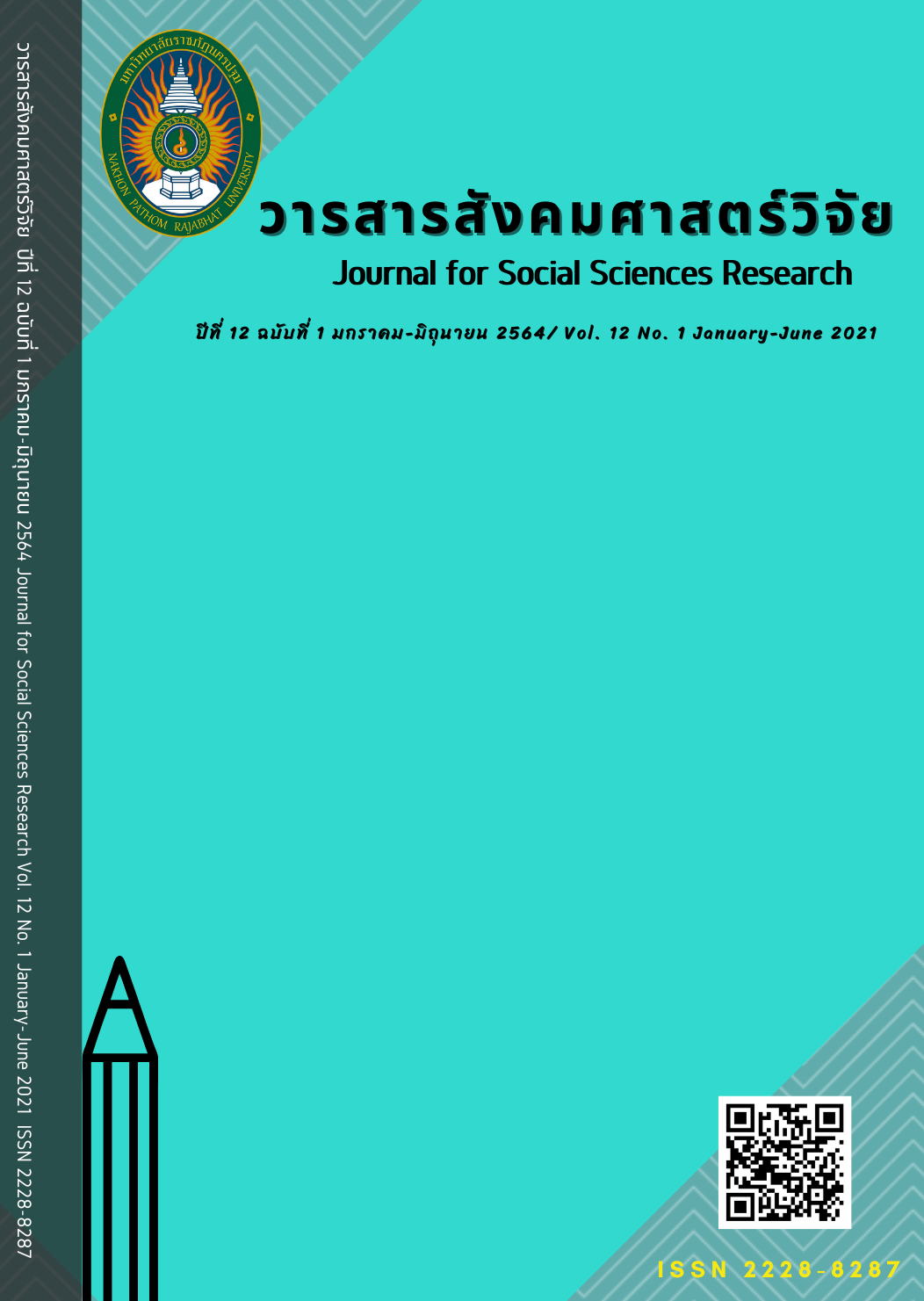ADAPTATION UNDER THE CORONAVIRUS DISEASE 2019 EPIDEMIC SITUATION OF MATTHAYOMSUKSA 6 STUDENTS OF RACHINEEBURANA SCHOOL
Main Article Content
Abstract
The objectives of this research were to: 1) study the adaptation of Matthayomsuksa 6 students of Rachineeburana School under the Coronavirus Disease 2019 (COVID-19) epidemic situation; and 2) compare the adaptation as classified by residence and number of years studying in the school. The research sample was Matthayomsuksa 6 students who was studying in the second semester of the academic year 2020 at Rachineeburana School, comprising 1) 297 questionnaire respondents derived by stratified random sampling, and 2) 14 interviewees derived by purposive sampling. The research instruments were a questionnaire and an interview form. Data were analyzed by arithmetic mean, standard deviation, independent t-test, and content analysis.
The results of this research were as follows.
- Overall the adaptation of students was at a high level. When considered each aspect, all aspects were at a high level. The social adaptation was at the highest level, followed by emotional adaptation, learning adaptation, and activity participating adaptation. Regarding the interview, for learning adaptation, students tried to provide technological equipment for online learning especially the internet network. For social adaptation, students perceived the prevention measures against the pandemic and acted accordingly; therefore they were able to adjust themselves without feeling that it was an obstacle to come to school. For emotional adaptation, students understood the difficulties of both their teachers and their peers so they expressed empathy and helped each other in learning both online and on site. Additionally, they were able to control their emotions as well, despite various obstacles in their lives. For activity participating adaptation, students understood that school activity participation was a good opportunity to learn to participate in new normal activities.
- Overall and in specific aspects, there was no difference in the adaptation of students as classified by residence and number of years studying.
Article Details
บทความที่ได้รับการตีพิมพ์เป็นลิขสิทธิ์ของมหาวิทยาลัยราชภัฏนครปฐม
เนื้อหาของแต่ละบทความเป็นทัศนะของผู้เขียน ซึ่งที่ปรึกษา บรรณาธิการ กองบรรณาธิการ และคณะกรรมการบริหารวารสารไม่จำเป็นต้องเห็นด้วย หรือร่วมรับผิดชอบใดๆ
References
กรรณิการ์ แสนสุภา และคณะ. (2563). การปรับตัวของนักศึกษาในสถานการณ์โควิด-19. วารสาร มจร มนุษยศาสตร์ปริทรรศน์, 6 (2), 79-92.
นันทิชา บุญละเอียด. (2554). รายงานการวิจัยเรื่อง การปรับตัวของนิสิตระดับปริญญาตรีชั้นปีที่ 1 คณะวิทยาศาสตร์ มหาวิทยาลัยบูรพา. ชลบุรี: มหาวิทยาลัยบูรพา.
นุชลี อุปภัย. (2555). จิตวิทยาการศึกษา. กรุงเทพฯ: สำนักพิมพ์แห่งจุฬาลงกรณ์มหาวิทยาลัย.
ประสาท เนืองเฉลิม. (2556). วิจัยการเรียนการสอน. กรุงเทพฯ: สำนักพิมพ์แห่งจุฬาลงกรณ์มหาวิทยาลัย.
พิชญาวดี กงบุราณ. (2551). ปัจจัยที่ส่งผลต่อการปรับตัวของพลทหารใหม่กองประจำการ สังกัดกองพันทหารราบที่ 3 กรมทหารราบที่ 1 มหาดเล็กรักษาพระองค์. ปริญญานิพนธ์การศึกษามหาบัณฑิต สาขาวิชาจิตวิทยาการศึกษา บัณฑิตวิทยาลัย มหาวิทยาลัยศรีนครินทรวิโรฒ.
ภาวิณี สุธีพิเชษฐภัณฑ์. (2545). การปรับตัวต่อการปฏิบัติงานพยาบาลเข้าสู่มาตรฐานระบบคุณภาพในโรงพยาบาลของนักศึกษาพยาบาล วิทยาลัยเกื้อการุณย์ กรุงเทพมหานคร. ค้นเมื่อ 28 เมษายน 2564, จาก https://opac.kku.ac.th/Catalog/BibItem.aspx?BibID=b00187275
ระวีนันท์ รื่นพรต, ธีรพัฒน์ วงศ์คุ้มสิน และงามละมัย ผิวเหลือง. (2553). ปัจจัยทำนายการปรับตัวของนักศึกษาระดับปริญญาตรี. วารสารรามาธิบดีพยาบาลสาร, 16 (3), 390-405.
รัตนะ บัวสนธ์. (2555). วิธีการเชิงผสมผสานสำหรับการวิจัยและประเมิน. กรุงเทพฯ: สำนักพิมพ์แห่งจุฬาลงกรณ์มหาวิทยาลัย.
ราชบัณฑิตยสภา. (2563). ราชบัณฑิตบัญญัติศัพท์คำว่า “New normal”. ค้นเมื่อ 20 มีนาคม 2564, จาก https://royalsociety.go.th
สำนักงานคณะกรรมการการศึกษาขั้นพื้นฐาน. (2563). แนวทางการจัดการเรียนการสอนทางไกลในสถานการณ์การแพร่ระบาดของโรคติดเชื้อไวรัสโคโรนา 2019 (COVID-19). กรุงเทพฯ: กระทรวงศึกษาธิการ.
สำนักงานคณะกรรมการการศึกษาขั้นพื้นฐาน. (2564). แนวทางการจัดการเรียนการสอนทางไกลในสถานการณ์การแพร่ระบาดของโรคติดเชื้อไวรัสโคโรนา 2019 (COVID-19) ระลอกใหม่. กรุงเทพฯ: กระทรวงศึกษาธิการ.
อวาทิพย์ แว. (2563). COVID-19 กับการเรียนรู้สู่การปรับเปลี่ยนพฤติกรรมสุขภาพในวันนี้. วารสารสมาคมวิชาชีพสุขศึกษา, 35 (1), 24-29.
อัชรา เอิบสุขสิริ. (2556). จิตวิทยาสำหรับครู. กรุงเทพฯ: สำนักพิมพ์แห่งจุฬาลงกรณ์มหาวิทยาลัย.
อิทธิพัทธ์ สุวทันพรกูล. (2562). การวิจัยทางการศึกษา: แนวคิดและการประยุกต์ใช้. กรุงเทพฯ: สำนักพิมพ์จุฬาลงกรณ์มหาวิทยาลัย.
Baker, R. W. & Siryk, B. (1984). Measuring adjustment to college. Journal of Counselling Psychology, 31 (2), 179-189.
Bernard, H. W. (1960). Mental health for classroom. New York: McGraw-Hill.
Best, J. W. (1995). Research in education. New Jersey: Prentice Hall.
Ferguson, G. A. (1989). Statistical analysis in psychology and education. New York: McGraw-Hill.
Krejcie, R. V. & Morgan, D. W. (1970). Determining sample size for research activities. Educational and Psychological Measurement, 30, 607-610.
Rogers, C. R. (1967). Client-centered therapy. Boston Houghton Mifflin.
Rovinelli, R. J. & Hambleton, R. K. (1977). On the use of content specialists in the assessment of criterion-referenced test item validity. Dutch Journal of Educational Research, 2 (1), 49-60.
Tindall, J. A. (1959). Peer counseling an in-depth look at training peer helpers. Muncie: Accelerated development.


